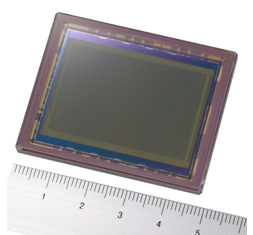Sony 24.8 megapixel full frame CMOS announced
Sony Corporation today announced the development of a 35mm full size (diagonal:43.3mm) 24.81 effective megapixel, ultra-high speed high image quality CMOS image sensor designed to meet the increasing requirement for rapid image capture and advanced picture quality within digital SLR cameras.

The sensor is going into production in 2008, which means that the launch of the predicted Alpha 900 will probably not be before the end of the year – with previews at photokina. Unless the A900 uses a 12 megapixel sensor as in the Nikon D3, and a further model will be announced even higher in the market, Sony users may be waiting until 2009 for their full-frame DSLR. Nikon would also be likely to release a D3X or variant (D4?) using the new sensor. The announcement just before PMA parallels last year’s announcement of the IMX021 sensor, which took place only three months before the Nikon D300 and Alpha 900 appeared. If production cycles are equally fast, the earliest time we could expect to see the new camera using the full frame sensor would be late Summer. The rest of this news item is in Sony’s words with some editing to improve the sense in English.
Development background
In recent years, the demand for digital SLR cameras featuring high resolution and wide graduation ranges capable of capturing every detail of the subject matter has continued to increase, particularly among high-end amateur users. Additionally, the increasing user requirement to shoot using the same focal length, angle of view and depth of field as 35mm SLRs using interchangeable lenses has led to significant interest in the development of 35mm, full size CMOS image sensors.
However, there are a number of technical challenges to developing full (large) size image sensors, such as the propagation delay caused by using extended power circuitry and signal lines, and the difficulty of maintaining uniform sensitivity and signal saturation across the surface of the screen (avoiding a patchy image – Ed).
It is therefore extremely important to accurately control exposure variance and match circuit patterns.
Advantages of this device
The newly developed CMOS image sensor combines unique circuit design technology with Sony’s advanced fabrication expertise – such as advanced planarization for minimizing fluctuation – to realize 35mm, full size, 24.81 effective megapixel resolution. Sony’s “Column-Parallel A/D Conversion Technique” also provides each column within the sensor with its own A/D converter, minimizing image degradation caused by the noise that arises during analog processing while at the same time delivering an extremely high signal conversion speed. This is the same method as used in the IMX021 APS-C size sensor.
The enhanced image quality generated by the sensor’s 24.81 effective megapixel resolution, wide range of graduation expression achieved by its full size broad dynamic range, and the low noise, high resolution, ultra-responsive performance provided by Sony’s Column-Parallel A/D Conversion technique enable it to meet the ever-increasing requirements within high performance digital SLR cameras.
Sony will target for mass production of this CMOS image sensor within this year.
Major features
- High picture quality in 35mm full size image sensor with 24.81M effective pixels
- “Column-Parallel A/D Conversion method” achieves high S/N and high-speed imaging
- CDS/PGA (24dB) Circuit (PGA: Programmable Gain Amplifier)
- 12-bit A/D Converter on chip
- Two types of readout mode:
- All-pixel scan mode – 6.3 frames per second (12-bit)
- Window readout (no explanation is given, and no details, but if this is not ‘All-Pixel’ it may be a cropped frame DX/APS-C mode, or more than one crop size – Nikon’s 12 megapixel sensor allows DX format or 5×4 ratio. The 16:9 panoramic mode of the Alpha 700 does not crop the raw file.
- High-speed digital output (12-channel parallel LVDS output)
Device Structure
Image size : Diagonal width 43.3mm (Type 2.7)
Total number of pixels: 6236(H) x 4124(V) approx. 25.72M pixels
Number of effective pixels: 6104(H) x 4064(V) approx.24.81M pixels
Number of active pixels: 6096(H) x 4056(V) approx.24.73M pixels
Chip assembly size: 41.0mm (H) x 31.9 mm (V)
Unit cell size: 5.94µm (H) x 5.94µm (V)
(this size is comparable to the Pentax/Samsung 14.6 megapixel APS-C format sensor)
Though there is no mention of the possibility of 14-bit A/D conversion, the architecture may permit a much slower transfer of data with external A/D converter, as Nikon has implemented in the D300. The maximum frame rate does not indicate that a 6.3 frames per second shooting speed would be achieved. The IMX021 offers a 10.3 frames per second maximum, but to date the fastest achieved is the Nikon D300 at 8fps. The Sony A700 only achieves 5fps and in practice this is more like 4.8-4.9fps. We would expect 6.3fps maximum potential to mean 5fps in practice, but possibly slightly less ambitious.
– DK

DK, thanks for staying on top of things for us!
It looks as if at least one of the Sony full frame offerings will be very expensive! I hope a couple “pro” offerings are on the way to suit the needs of all of us that are looking for full frame.
Hopefully, noise performance will be an improvement on this, which is already pretty good:
http://www.sonolta.com/sony-photos/v/Money+Shots/
We know it will be great for these types of shots:
http://www.sonolta.com/sony-photos/v/Sony-a700-photos-autumn/
So, will the sensor have “dual” modes to handle both high ISO and high resolution??
I guess it is back to wait and see for a few more months.
-Sonolta
http://www.sonolta.com